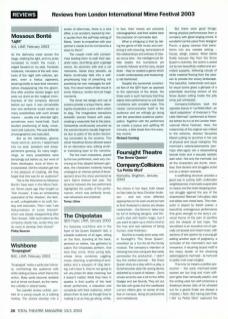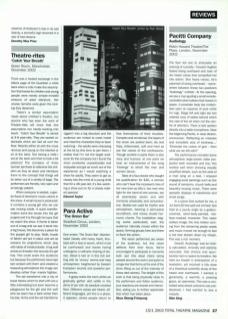Two shows in two days, both based on fairy tales by Hans Christian Andersen – and two more different approaches to his work would be hard to find! Andersen's stories are always melancholic – the Grimms' tales may be full of terrifying dangers, and Perrault's shot with fearful magic, but if you want to open up a child's mind to the true and real sadness of being human, read Andersen.
But this is mostly done away with in Foursight's The Snow Queen, reworked as a fun-for-all-the-family musical. The company's intention of showing how love conquers fear rarely permeates the production. I didn't buy the central premise – the Snow Queen story as a play-within-a-play, a Scheherezade-style life-saving device delivered by a band of robbers – Zanni whose accents owe a lot to the Artful Dodger and Joe Grundy. They act out the tale with gusto but the cardboard cut-out villains give no sense of real fear or menace, being all pantomime and melodrama.
But there were good things: strong physical performances from a company with great singing voices. A wonderful centre-piece from designer Purvin, a gypsy caravan that transforms into any needed setting – house, sleigh, palace. When Gerta finally rescues Kay from the Snow Queen's clutches, the scene is acted out by two beautifully crafted and animated puppets, billowing clouds of white material flowing from the caravan to provide the snowy landscape. This beautiful, melancholic and soulful visual scene gives a glimpse of a potentially stunning version of the Snow Queen sitting inside the jolly romp just witnessed.
Company:Collisions took the opposite stance in La Petite Mort, an 'adult adaptation of Andersen's The Little Mermaid (performed at Komedia before its run at the London International Mime Festival). Here, the melancholy of the original was milked to the extreme, director Tanushka Marah pulling no punches in her use of physical and visual metaphor. The mermaid's sisters/adversaries (perhaps alter-egos) are a sleepwalking blonde bride and a sexually sadistic dark witch. Not only the mermaid, but all the characters are dumb, voiceless: their desires and struggles acted out as a dream-scenario.
A scaffolding structure provides a good way to portray both underwater weightlessness (mermaids suspended on ropes) and the heart-stopping physical struggle against the sea of the shipwrecked Beloved (who grips, slips and slides over metal bars). This character is played by Sarah Leaver, a beautifully androgynous performance that gives strength to the story's universal theme of the pain of sacrifice and the despair of lost hope. The soundtrack is an evocative mix of specially composed and mixed music, with sections of text spoken by a young girl adding another layer of poignancy, a reminder of the mermaid's own lost innocence. A recurring sound motif is the heavy breath of the drowning sailor / orgasmic mermaid – la mort and la petite mort ever-mingled.
This is by no means a perfect production – the early mermaid-sister scenes are too long and more soft-porn girlie than sensually playful, and the ending uses too self-conscious a theatrical device (bits of kit wheeled out for a grand finale are always a mistake, I feel). But having said that, I felt La Petite Mort captured the essence of Andersen's tale in its sad beauty, a sorrowful sigh drowned in a sea of lost dreams.


